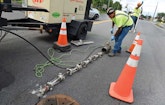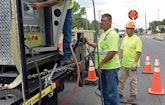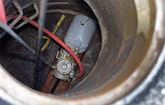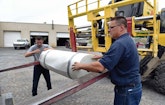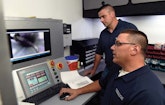
Interested in Cleaning?
Get Cleaning articles, news and videos right in your inbox! Sign up now.
Cleaning + Get AlertsPrecision Trenchless has risen to the top by embracing challenges and investing in cutting-edge technology to successfully meet those challenges.
Being in the right place at the right time doesn’t hurt either, says Mike App, senior project manager at Precision Trenchless, based in Schenectady, New York: “Timing is everything — no doubt about that.”
Specifically, there were two main factors that spurred the company’s growth: UV-cured lining technology, and the company’s decision to focus on rehabbing large-diameter pipes (24 to 63 inches in diameter) — an underserved market many contractors avoided.
“If things go bad on a large-diameter pipe project, they go bad faster and it becomes very expensive to fix,” App explains. “So the bigger you go (in pipe diameter), the less competition there is. There are very few other companies nationwide that do large-diameter pipe rehab because it’s such a high-risk, high-reward proposition.”
At first the UV-cured technology was a tough sell, because most potential customers were only familiar with felt-liner applications. “It took a long time to get any momentum going,” App notes. “But once we got those first couple of jobs under our belts, we could refer those customers to prospective customers. That’s how we started gaining momentum.”
Success with UV
About five years ago, a large client asked Precision’s sister company, Precision Industrial Maintenance (PIM), for help in resolving an ongoing problem with thousands of feet of storm sewer lines the client owned. At the time, PIM had been cleaning and inspecting sewer lines for two decades.
The sewer lines had been periodically rehabbed with traditional, steam-cured felt liners that never cured correctly and kept coming apart whenever the lines were jetted. But as luck would have it, Todd Kilburn, Precision’s owner and founder, was looking into CIPP lining technology and had an answer to the client’s request for a better way to seal the lines: a fiberglass lining system made by Germany-based SAERTEX-multiCom that uses UV light for curing.
Long story short, Precision successfully installed the SAERTEX lining system, which proved to be a reliable technology. So by trying to better serve a client, Precision Trenchless was born into Precision Group, which also comprises PIM and Precision Environmental Services.
“Todd is an entrepreneur. He researches new ideas and has the uncanny ability to look down the road eight or 10 years and spot emerging trends,” App says. “And now, with all the aging infrastructure needs, pipe lining has become a burgeoning industry and we already were well positioned to become a leading service provider.”
After that initial UV lining job, Precision Trenchless used the old-fashioned shoe-leather approach to gaining market share, explaining the benefits of the technology to municipal engineers. As such, the company often took on tough jobs that other contractors had repeatedly passed on because of their complexity — and inherent risk of failure. “We’d say, ‘We can do this,’ then went out and did it,” App says. “And that’s how we started building a client base — and a good reputation.”
Targeting tough jobs
A good example of the challenging jobs Precision Trenchless hones in on occurred in 2014 in Kingston, New York. After heavy spring rains produced a sinkhole in a city street, large volumes of silty sediment began rushing into a 24-inch-diameter, vitreous-clay sanitary sewer known as the Tannery Brook Tunnel, which lays about 90 feet underground. The silt infiltrations were causing problems at the city’s wastewater treatment plant.
About 190 feet of the sewer line was affected by the sinkhole, but enough pipe remained to rehabilitate it. Inside the line, the temperature was a cool and constant 53 degrees, and it was constantly wet because of multiple 60 gpm leaks. The situation called for a quick-curing liner, and the SAERTEX system fit the bill, App says.
Workers gained access to the sewer line via a 90-foot-deep shaft. The work also required a 4-inch-diameter bypass system, capable of handling 900,000 gpd. Despite the difficult work conditions, which included more heavy rains, Precision Trenchless workers finished the job in 2 1/2 weeks, with no further infiltration to date.
Different hiring approach
App took a simple and unorthodox approach to hiring his pipe lining team: No experience required.
“Only two of the guys we hired had ever installed liners before,” he says. “We intentionally went mostly with guys who had no experience. We didn’t want them to have any expectations, preconceived notions or bad habits. It’s hard to take a felt crew and teach them to do UV-cured work. In fact, it’s unusual to find a lining company that does felt and also does UV. They’re just different enough in terms of the process and installation that if you don’t do UV work day in and day out, it’s difficult to do.”
To attract and retain quality employees, Precision Trenchless offers competitive pay and benefits. But it also offers employees intangibles like upward mobility within the company and an open door to share ideas and opinions. “The biggest thing Todd and I do differently is give every employee a voice,” App explains. “I trust them and listen to them. We believe in developing and improving our field technicians, leads and supervisors, and letting them follow their passions within the company.
“I can honestly say that out of all the employees I’ve hired, only one has left the company — and that was for family reasons,” he continues. “We thank them all the time and treat them well because we live on the road a lot. We offer flexible work schedules so they can get back home for, say, a child’s recital or sports event. We feel that as their employer, it’s our responsibility to minimize the chances that they miss those kinds of things.”
Precision Trenchless provides in-house training, but App notes that the in-the-field experience is equally as valuable as the technical education employees receive. “Anyone can learn to do pipe lining, but we really distinguish ourselves from the rest when things go wrong,” he says. “What sets us apart is how we work out of jams to make sure every client is satisfied.
“That inventiveness where employees can think on the fly and solve problems only comes from experience,” he adds. “All pipe liners have basically the same equipment, but it’s what you’re willing to do with it — what your employees can do — that makes a big difference.”
Large equipment fleet
The company believes that investing in new, reliable equipment helps to attract and retain employees. To that end, and to better serve customers, Precision Group owns two Vac-Con jet/vac trucks built on International 7600 chassis with 1,500-gallon debris tanks and 1,000-gallon water tanks, two jet/vac trucks built by Vactor Manufacturing on Kenworth T80 chassis with 1,500-gallon debris tanks and 1,000-gallon water tanks, and a Guzzler vac truck built on an International 2674 chassis.
The fleet also includes an International 4700 box van for carrying lining gear, a wet/dry vacuum truck built on an International 5500 chassis, a Caterpillar backhoe, a trailer-mounted John Bean Jetters water jetter, and two Mercedes-Benz 3500 Sprinter inspection vans equipped with Aries wheeled Pathfinder cameras.
“When needed, we share equipment and personnel between Precision Group companies,” App says, noting the advantages of having a diversified, full-service group of service providers.
“The synergies between our companies provide a big advantage because it’s more convenient and cheaper for customers to work with just one contractor.”
The bulk of Precision Trenchless’ work currently comes from lining sewer trunk lines and culverts that run under highways and roads; the rest comes through contracts with various states’ transportation departments. But the company isn’t a two-trick pony: It is also expanding into other pipe lining applications. For example, this year a Precision crew will finish lining an 11 1/2-mile-long pipeline that delivers water from a reservoir to residents in the city of Boulder, Colorado.
Further growth anticipated
Looking ahead, App is confident that Precision Trenchless will continue to grow, for several reasons. First, he predicts infrastructure deterioration will worsen and become a more visible problem, which should encourage more funding to resolve the problem. “The Flint situation (lead-contaminated water pipes) has put the country’s underground infrastructure under a microscope,” he points out. “People need to have safe drinking water and trust in their roads and other basic services.”
Moreover, App believes in Kilburn’s entrepreneurial spirit, which keeps employees motivated. “We plan to expand our geographic footprint,” he says. “Our goal is to double our size (in terms of gross revenue) during the next five years and become the single largest UV-liner installer in the United States.”
There’s also another factor at work that’s less tangible but equally important: employees’ zeal to tackle challenging jobs and their passion for excellence.
“We’ll do anything to get a job done,” App says. “We feel privileged to do this — honest to God, we do. I love every day we come to work.”
Shape-shifting sewer line poses multiple challenges
A unique attitude toward tough jobs prevails at Precision Trenchless in Schenectady, New York: Bring ’em on. But the company almost met its match when it won a contract to line a leaking, 140-foot-long section of combined storm and sanitary sewer in Boston’s historic Beacon Hill neighborhood in April 2016.
While 140 feet of sewer may not seem like a big deal, the job posed plenty of challenges. First of all, it was constructed more than 100 years ago and now runs under a narrow, 9-foot-wide road. Secondly, the brick sewer line’s shape changed every 25 feet or so; some sections were circular, some were elliptical and yet others featured a flat slate ceiling.
Even worse, the lateral lines from the brownstone townhouses that line both sides of the street connected to the bottom of the sewer line. “It got to the point where every time it rained, the houses would flood,” explains Mike App, senior project manager for Precision Trenchless. “When the storm sewer backed up with water, it would go down the laterals and flood the basements.” So in addition to lining the pipe, another contractor was changing the lateral connection points to the top of the sewer line.
Precision Trenchless gained access to the line via three manholes — one at each end of the affected stretches of pipe and one in the middle — plus two additional excavation pits that helped segregate the different-shaped sewer sections to some degree.
It was tricky getting the fiberglass SAERTEX liner to accommodate the different sewer sizes, but nylon safety caps installed at each transition point helped the liner conform to the various host pipe shapes with diameters ranging from 13 to 18 inches, App says. The end result: The project was completed in three days, on time and on budget.

